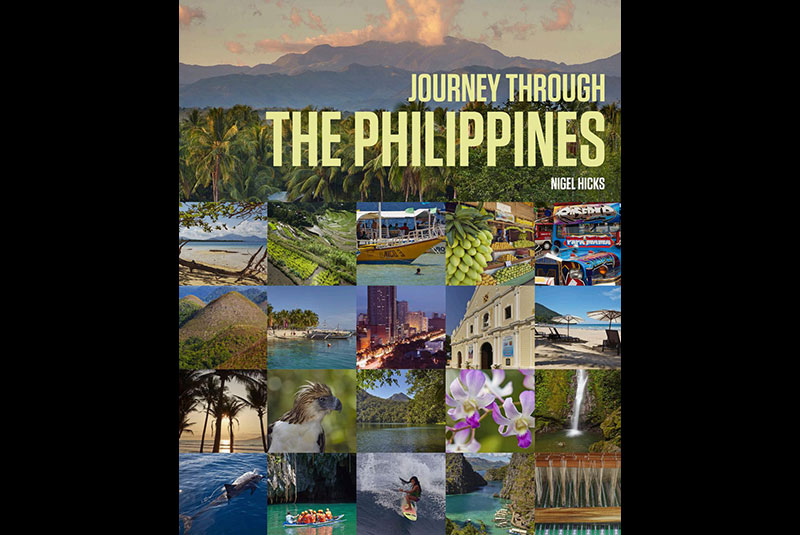The Philippines through Nigel Hicks’ eyes

People today really are traveling like the hourglass is fast running out of powder-white sands. Which perhaps it is. This pictorial journey through the Philippines preserves it, without sugarcoating it.
Journey Through The Philippines
By Nigel Hicks
176 pages, John Beaufroy Publishing
Available at National Book Store
The first paragraph of Nigel Hicks’ handsome travelogue of the Philippines makes you pause for a minute. “Traveling around the Philippines is always a memorable experience, particularly when moving around by boat or by bus.” The long-timer such as myself stops to reflect on bus rides to Banaue, marked by repeat viewing of B-movies starring Steve Segal to reduce the sheer boredom of eight hours planted in a bumpy seat interrupted by infrequent pee stops. And those bancas — romantic enough, except for the smell of diesel and the choppy waters converting your insides to your outsides. Still, as Hicks notes, “…every journey is packed with energy, action and adventure; there really is hardly a dull moment.”
One flashes back on near-lethal pedicab rides around Bora or Puerto Galera, full of adventure and rates (both heart and fare) that suddenly shoot up once one eventually ambles to one’s destination.
But I get what Nigel Hicks means. He’s not one to find romance on super-sleek buses or high-speed ferries. The British photographer likes to get down into the details, the sweat and grit. But Journey Through The Philippines offers some of the most sumptuous shots of this country, prime picks for DOT advertising, that I’ve seen in over a decade. (It helps that the Department of Tourism endorses the book.) Charting 30 different locations throughout the country’s 7,107 islands, Hicks really makes it postcard-perfect. For those who have never visited Paradise before, you will find some examples in these pages. Whether it’s the peaks of Coron Island, the Kabugan Falls in Pagudpud, or surfers at Cloud Nine, Siargao, Hicks has got an eye for the inherent beauty of the Philippines. Heck, he even makes the desultory zebras trapped on Calauit look enchanting.
More importantly, Hicks has gathered together the destinations that will appeal to budding photographers (or Instagrammers), younger tourists and visitors, mixing it with lively ground details. You won’t see any squalor (of course), but you do get a ground-level view of the locals, and the festive mood.
I’ve always thought there should be a travel guide devoted to the oddities of Philippine culture — things like cockfights and midget boxing and Senate sessions — but that one will have to wait.
Here, we see the Philippines province by province, starting in Luzon — with stops from north to south in Pagudpud and Laong, through Vigan and Baguio, Sagada, Pinatubo and Metro Manila, ending in Bicol; next we bus or banca to Mindoro and Palawan, setting down in Puerto Galera, The Calamian Islands, El Nido, Puerto Princesa and Honda Bay; the journey continues through the Visayas, encompassing Boracay, Guimeras, Cebu, Mactan Island, Dumaguete, Siquijor and Bohol; and naturally the trip passes down through Mindanao, to the President’s home turf of Davao, Camiguin, Siargao and Zamboanga.
The photos are pretty and sometimes spectacular, but not overly pretty, if you know what I mean. They capture life the way it is for a tourist stepping right into the frame of the Philippines, without a lot of filters and buffers.
Similarly, Hicks does not sugarcoat the locations in his write-ups. He will comment, for instance, that the Whale Shark experience in Donsol is a remarkable tourism opportunity for the area, but note that the cloudy waters can make visibility difficult — until the eight-meter Whale Shark is literally inches from your face. He will talk about the popularity of White Beach in Puerto Galera, but note that its tourism development has been haphazard, resulting in a location that is “ugly.” You will get the true picture from his commentary, in other words.
Hicks has written, in addition to four other books on the Philippines’ beauty, travel guides to Southeast Asian locales, diving spots and naturalists’ guides. Despite the disconnect prospective Philippine tourists may feel, between Duterte’s pronouncements on one side and critical brickbats about human rights violations on the other, we really are in a time when people are traveling like the hourglass is fast running out of powder-white sands. Which perhaps it is. Just a glance at the increased fisticuffs on flights over oversold seats tells us that, terror warnings or not, people gotta get to where they’re going. The world is a smaller place, and people want to check out those places they see in Instagram and FB posts, whether it means taking a bumpy bus or banca ride to do it, possible beheadings be damned. In that sense, the terrorists have lost, big-time.
Another valuable thing about Journey through the Philippines is that it captures the country’s tourism picture at a certain moment in time. We don’t know if things will look different in 10 years with greater numbers flocking to these shores, perhaps Chinese and other tourists becoming a bigger factor. Will infrastructure projects change the landscape of these pristine vistas? Will some things — like local fiestas and tarsier habitats — become a quaint memory? Will the Philippines preserve its great resources of natural beauty?
Fortunately, Hicks’ pictorial journey through the Philippines does preserve it, without sugarcoating it. It’s a journey that even Filipinos looking for local adventures will want to check out.
* * *
Visit www.nigelhicks.com/PhilippinesBeautiful.html.



















